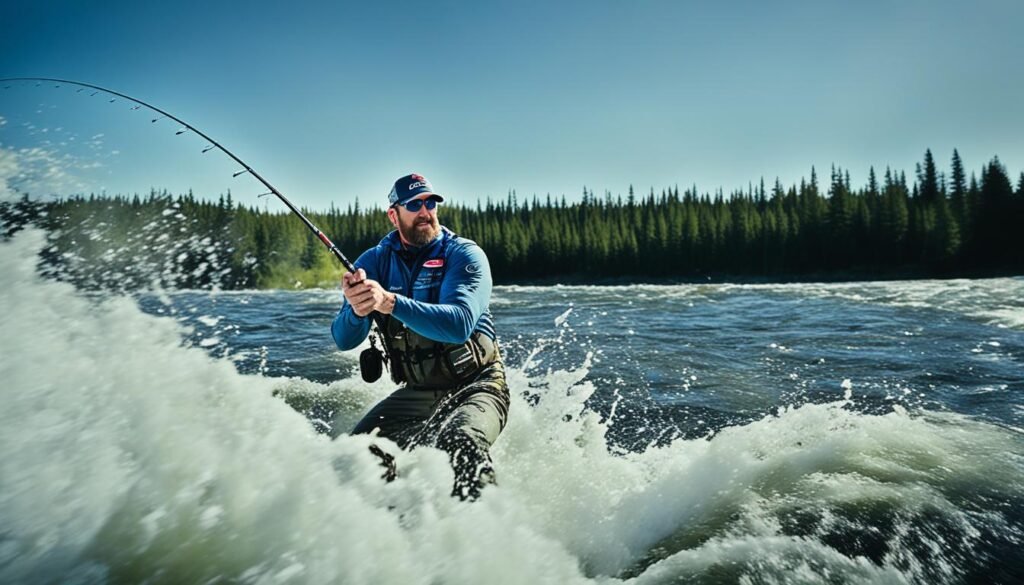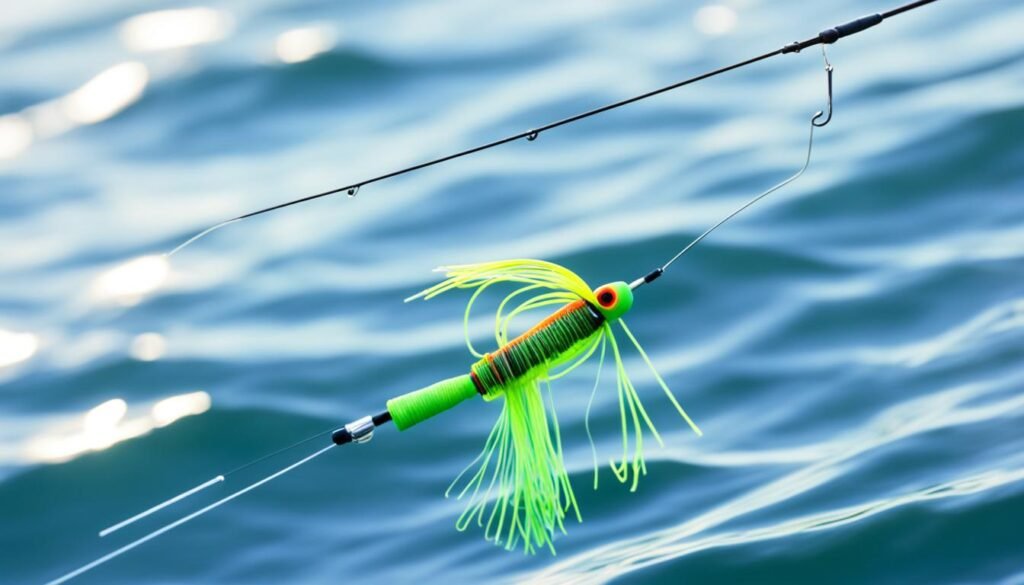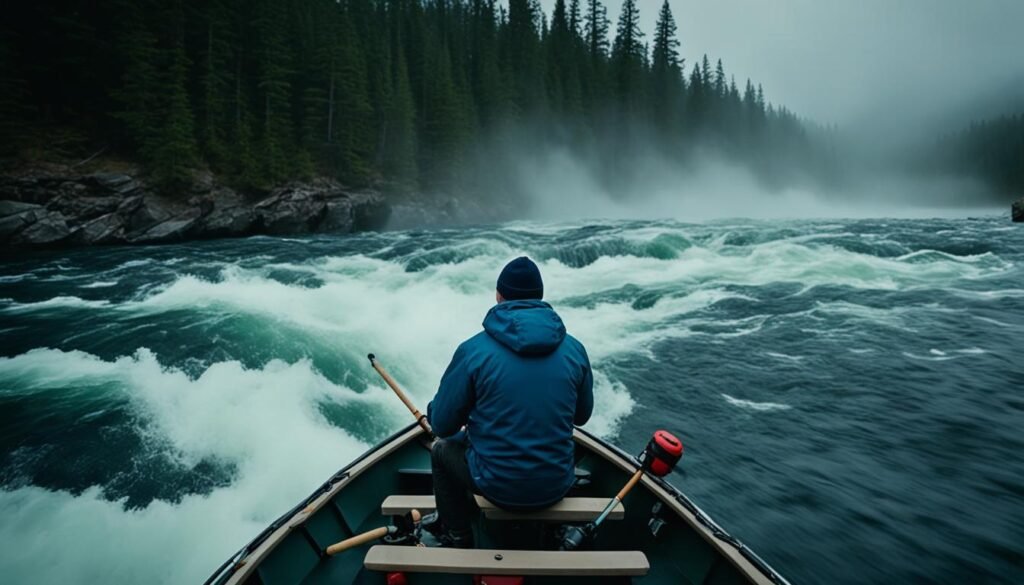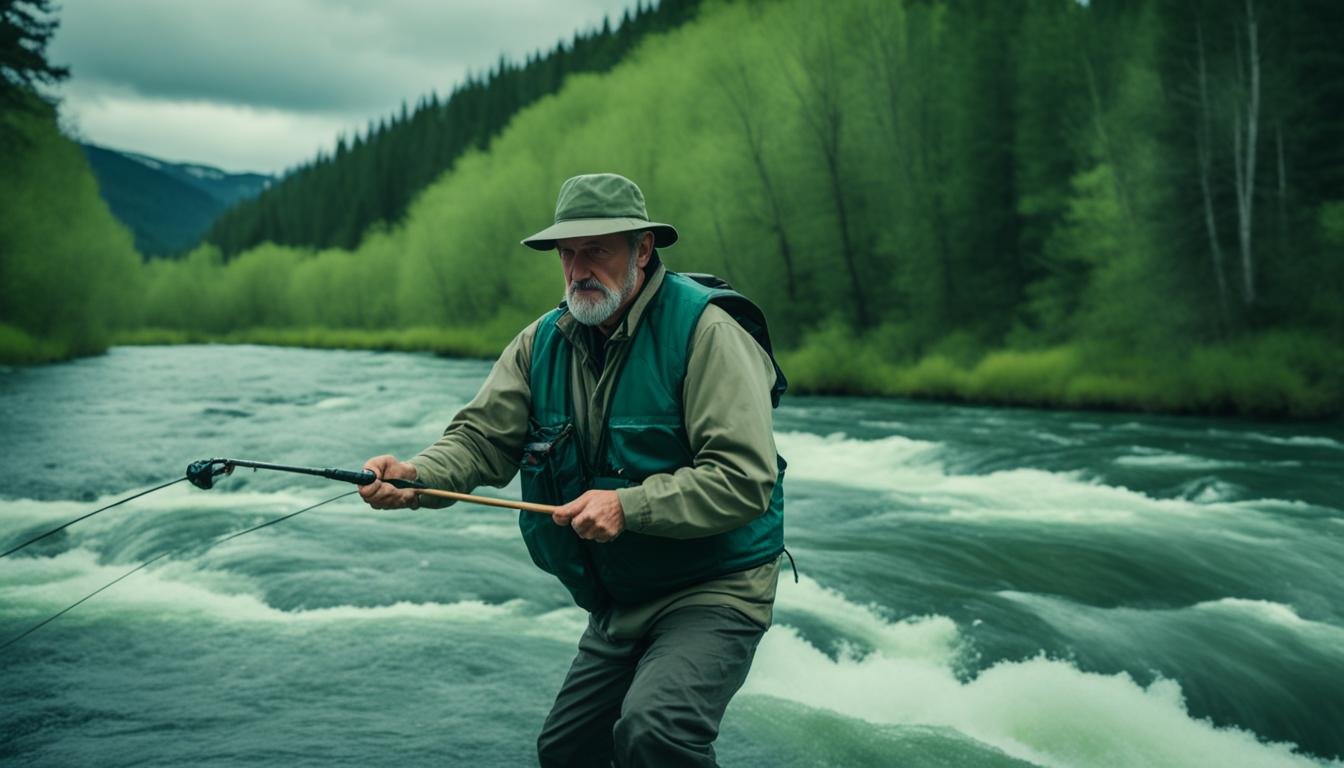Navigating the powerful currents that sweep through Canada’s vast river systems can be a daunting challenge for even the most seasoned anglers.
Yet, these same strong flows can also harbor incredible opportunities to land trophy-sized fish. So, what’s the secret to conquering the currents and maximizing your chances of success?
In this comprehensive guide, we’ll dive deep into the techniques and strategies that the top current fishing experts use to tame the whitewater and land big catches in Canada’s premier river systems.
From understanding the unique behavior of fish in fast-moving waters to mastering specialized lures and presentation methods, you’ll learn everything you need to become a successful current fishing angler in the Great White North.
Key Takeaways about Fishing in Heavy Currents
- Strategies for navigating and fishing in heavy river currents
- Techniques for targeting trophy-sized fish in strong flows
- Specialized lures and tackle for current fishing
- Safety precautions and gear for fishing in whitewater conditions
- Proven methods for locating and catching lake trout in rivers
Conquering the Challenges of River Fishing
Venturing into the realm of river fishing can be an exhilarating, yet demanding endeavor. To consistently find and catch fish in the dynamic, current-swept environments of Canadian waterways, anglers must possess a deep understanding of how fish behave in these conditions. Additionally, closely analyzing the ever-changing river conditions is crucial for unlocking the keys to productive, current-savvy fishing strategies.
Understanding the Behavior of Fish in Currents
Predatory species like lake trout and bass often seek out areas of refuge and ambush in river systems. They tend to hold in eddies, depressions, and current breaks where they can conserve energy and efficiently intercept passing prey. By recognizing these strategic locations, anglers can pinpoint the best spots to target these opportunistic feeders.
In high water or during spring runoff, visibility in the water can be severely reduced due to murky, turbulent flows. In such conditions, fish often retreat to deeper, slower-moving pockets and holding areas, where they can more easily locate and capture their next meal. Adapting lure selections and presentation techniques to match these challenging environments is essential for consistent success.
Assessing River Conditions for Optimal Fishing
- Water depth: Deeper holes, pools, and depressions often harbor higher concentrations of fish during periods of strong current.
- Flow speed: Understanding the velocity of the water flow can help anglers pinpoint the prime ambush points and current breaks where fish will congregate.
- Underwater obstructions: Boulders, fallen trees, and other submerged structures create eddies and slower water that attract predatory species.
By carefully analyzing these key river conditions, anglers can strategically position themselves to intercept the movements and feeding patterns of their target species. This knowledge, combined with the right tackle and techniques, is the foundation for conquering the challenges of river fishing in Canada.
“The river is never the same. It’s always changing, always different. That’s what makes it so challenging and so rewarding.” – Fly Fishing Enthusiast
Mastering Drop Back Jerk Bait Techniques

One of the most effective techniques for Drop Back Jerk Bait Fishing in heavy currents is the drop-back jerk bait presentation. This involves slowly working Current Fishing Lures, such as the Rapala Shadow Rap Shad Jerkbait, Rapala Shadow Rap Jerkbait, and Rapala Husky Jerk Jerkbait, through prime fish-holding areas, allowing the Jerk Bait Presentations to drift and flutter with the current.
Lake trout and other species will often aggressively strike these baits as they move through their feeding zones. Mastering the drop-back technique, including lure selection and retrieval, is a crucial skill for anglers targeting currents.
| Lure | Length | Weight | Diving Depth | Colors |
|---|---|---|---|---|
| Rapala Shadow Rap Shad Jerkbait | 3-1/2 inches | 3/8 ounces | 3-4 feet | 21+ |
| Rapala Shadow Rap Jerkbait | 4-1/4 inches | 7/16 ounces | 2-4 feet | 20+ |
| Rapala Husky Jerk Jerkbait | 3-1/8 to 4-3/4 inches | 1/4 to 7/16 ounces | 4-8 feet | 15+ |
To enhance the effectiveness of drop-back jerk bait presentations, anglers can modify the bait’s action by using the VMC Bladed Hybrid Treble Short 1X Hook, which can alter the bait’s sinking or floating behavior. Additionally, the choice of line, such as Berkley Trilene 100% Fluorocarbon or Berkley Trilene Sensation Professional Grade Monofilament, can significantly impact the lure’s presentation and performance.
The Abu Garcia REVO IKE Casting Reel with a 6.6:1 gear ratio and the Abu Garcia Ike Delay Series Casting Rods are well-suited for drop-back jerk bait fishing, providing the necessary control and sensitivity for this technique.
When the water temperature drops, soft, muted lure colors are preferred to appeal to bass effectively in winter conditions. Mastering the drop-back jerk bait presentation can be a game-changer for anglers targeting heavy currents in Canadian waters.
Fishing in Heavy Currents with Spoons
When it comes to conquering the challenges of fishing in heavy currents, spoons are a versatile and effective lure choice. These metal lures are renowned for their ability to attract predatory fish, including the elusive pike, in fast-moving waters. By understanding the nuances of casting and retrieving spoons, as well as the art of fluttering them, anglers can unlock a world of success in Canadian river systems.
Casting and Retrieving Spoons in Currents
The key to effectively fishing spoons in heavy currents is to allow the lure to sink and drift with the current, while still imparting enough action to entice strikes. This can be achieved through a slow and steady retrieve, avoiding the temptation to add twitches or pops that may appear unnatural to the fish. Spoons are particularly advantageous due to their weedless properties, allowing anglers to cast them into thick grass lines and around obstacles without getting snagged.
The Art of Fluttering Spoons
Another proven technique for spoon fishing in currents is the art of fluttering. By casting the spoon out and holding it in the current, anglers can allow the lure to pulse and flutter, creating an irresistible presentation for predatory fish. This method takes advantage of the spoon’s inherent action, allowing the angler to present the lure in a natural and enticing way.
To enhance the effectiveness of spoon fishing, anglers can utilize resources such as the Weekend Game Plans, Smart Fishing Spots Platform, and Community Reports to gain valuable insights into targeted fishing areas, feeding trends, and weather forecasts. By combining this information with the proper techniques for casting, retrieving, and fluttering spoons, anglers can dramatically increase their chances of success when faced with the challenges of fishing in heavy currents.
| Lure | Effectiveness | Recommended Techniques |
|---|---|---|
| Spoons | Highly versatile, can be cast, trolled, or vertically jigged for success |
|
By mastering the techniques of spoon fishing in heavy currents, anglers can unlock a new level of success in their Canadian river fishing adventures. Whether casting, retrieving, or fluttering these versatile lures, the rewards of landing a trophy fish in challenging conditions are sure to leave a lasting impression.
Jigs: Versatile Lures for Current Fishing

Anglers seeking to conquer the challenges of fishing in heavy currents often turn to a trusty lure: the jig. Jigs, especially bucktail jigs, are incredibly versatile tools for navigating the turbulent waters of Canadian rivers and streams. With their ability to be pitched upstream, allowed to drift down, or vertically jigged in deep pools and holes, these lures offer a diverse range of presentation options to match the ever-changing fishing conditions.
Pitching and Drifting Jigs in Currents
One effective technique for fishing jigs in currents is the pitching and drifting method. Anglers can cast their jigs upstream and let them drift back down, mimicking the natural movement of baitfish in the current. This approach allows the jig to cover a large area and entice strikes from predatory fish lurking in the depths. By experimenting with different jig weights and retrieves, anglers can dial in the most productive approach for the day’s fishing situation.
Vertical Jigging in Deep Pools and Holes
In addition to drifting jigs, vertical jigging can be a highly effective technique for targeting fish in deep pools and holes. By lowering a jig straight down and imparting a subtle, rhythmic action, anglers can attract the attention of suspended or bottom-dwelling predators. The variety of jig weights and profiles available allows anglers to precisely match the presentation to the depth and current conditions, increasing their chances of success.
Whether pitching and drifting or vertical jigging, the versatility of jigs makes them a go-to choice for anglers navigating the heavy currents of Canadian waterways. By mastering these techniques, anglers can unlock the full potential of these versatile lures and enjoy productive fishing days, even in the most challenging conditions.
“Jigs are an absolute must-have in my tackle box when fishing in strong currents. The ability to adjust the weight and presentation to match the conditions is a game-changer.”
– Rennie Robinson, Avid Canadian Angler
Tackle and Gear for Fishing Heavy Currents

Anglers tackling the challenges of fishing in heavy currents must be equipped with specialized tackle and gear to increase their chances of success. The right rod, reel, line, and sinkers can make all the difference when battling strong river flows and powerful lake currents.
When it comes to rods, a medium-heavy to heavy action is essential. These sturdy rods provide the backbone needed to control lures and keep fish from being swept away by the current. High-capacity reels, capable of holding plenty of heavy braid or fluorocarbon line, are also a must-have for current fishing.
Selecting the appropriate line is crucial. Braid or fluorocarbon lines in the 20-30 lb test range offer the strength and abrasion resistance required to withstand the constant rubbing against rocks and other underwater obstacles. These lines also provide the sensitivity needed to detect subtle bites in the turbulent water.
Anglers must also carefully choose the right sinker weights to keep their lures and baits in the strike zone. Pyramid and sputnik sinkers are particularly effective for surf fishing in strong currents, as they maintain contact with the bottom and prevent constant snags. Adjusting the rig and weight based on the current strength is key to staying on the fish.
“Investing in the proper tackle and gear can make the difference between frustration and triumph when battling strong currents.”
Specialized equipment, such as scrounger-style jigheads and finesse jigs, are also valuable tools for current fishing. These lures are designed to stay stable and maintain contact with the bottom, even in swift flows, making them ideal for targeting bass and other species in challenging river and stream conditions.
By equipping themselves with the right tackle and gear, anglers can overcome the obstacles posed by heavy currents and increase their chances of success on the water. From rods and reels to specialized lures and sinkers, the proper setup can make all the difference when fishing in Canada’s powerful rivers and lakes.
Current Deflection Methods and Safety

Fishing in powerful currents requires careful consideration of safety. Anglers should employ current deflection techniques to navigate these treacherous waters safely. By utilizing rocks, ledges, or other obstructions to redirect the flow, anglers can create calmer pockets where fish may be more likely to hold.
Understanding proper wading and boat handling techniques is crucial when navigating strong currents. Wearing the right personal protective equipment, such as life jackets and wading belts, can also help mitigate the risks associated with current fishing. These river fishing safety practices are essential for ensuring a successful and safe fishing experience.
Utilizing Current Deflection Techniques
The Coriolis force, generated by the rotation of the earth, causes air and water to deflect to the right in the Northern Hemisphere and left in the Southern Hemisphere. This phenomenon can significantly impact the behavior of currents in large bodies of water, such as lakes and rivers.
In large lakes like Ontario and Superior, water currents can bend as much as 45 degrees to the right of the wind direction. This current deflection can create calmer pockets and eddies that are ideal for targeting fish. By strategically positioning themselves near these current-deflecting structures, anglers can increase their chances of success.
Navigating Powerful Currents Safely
Proper wading and boat handling techniques are crucial when fishing in strong currents. Fish in shallower water usually face into shallow surface currents, while those deeper than about 5 feet might face the opposite direction – into a reverse current. Understanding these current patterns can help anglers maintain their balance and control while wading or maneuvering their boats.
Wearing the right personal protective equipment, such as life jackets and wading belts, can also enhance safety when fishing in powerful currents. These safety measures can help prevent accidents and ensure a more enjoyable and successful fishing experience.
“The wave-caused turbulence zone can lead to the disarray of schools of prey like shad or bluegills and make them vulnerable to predator attacks.”
| Current Deflection Factor | Degree of Deflection |
|---|---|
| Large Lakes (e.g., Lake Superior) | Up to 45 degrees |
| Medium-Sized Lakes (e.g., Lake Mendota) | Approximately 20 degrees |
By understanding and utilizing current deflection techniques and following river fishing safety practices, anglers can navigate powerful currents with confidence and increase their chances of success when targeting fish in these challenging environments.
Targeting Lake Trout in Rivers and Currents
Lake trout are not just deep-water fish – they can be found in shallow, fast-moving rivers as well. These current-loving lake trout are both aggressive and hard-fighting. Techniques like drop-back jerk baits, spoons, and jigs can be highly effective for targeting lake trout in river environments. Understanding where these fish like to hold and the best ways to present lures in the current are key to success when pursuing river-dwelling lake trout.
While lake trout are often perceived as deep-water predators, in regions like the southern Yukon, they frequently venture into shallow waters for food and thermal relief. These migratory fish can be found in rivers, especially during the spawning season in the fall when they move into currents to feed on returning adult and juvenile fishes, as well as other species like suckers, whitefish, and ciscoes.
Fishing in areas with currents can be productive in both fall and spring, as the moving water carries prey into the lake, providing favorable conditions for lake trout to feed before the winter. Effective tactics for targeting lake trout fishing in currents include using big spoons, drop-back jerk baits, and vertical jigging with jigs that imitate common forage species.
| Technique | Effectiveness for River-Dwelling Lake Trout |
|---|---|
| Drop-Back Jerk Baits | Highly Effective |
| Spoons | Highly Effective |
| Jigs | Highly Effective |
When fishing for lake trout in rivers and currents, it’s important to target areas where these fish like to hold, such as near current seams, eddies, and deep pools. Presenting lures in a natural, lifelike manner that mimics the movements of their prey is crucial for success.
“In northern waters, lake trout move shallow for spawning when water temperatures are above 40°F and back shallow in fall when temperatures drop below 50 to 52°F. The sweet spot for shallow water lake trout is between 46 and 48°F.”
By understanding the behavior and habitat preferences of river-dwelling lake trout, anglers can develop effective tactics to target these powerful fish in the fast-moving currents of Canada’s waterways.
Navigating Powerful Currents Safely
Fishing in heavy currents presents significant safety challenges that must be addressed. Proper wading and boat handling techniques are essential to avoid dangerous situations. Anglers should wear life jackets, use wading belts, and consider the use of a wading staff or trekking pole to maintain stability in swift waters.
Wading and Boat Handling in Fast-Moving Waters
Navigating currents safely while wading or operating a boat requires specialized skills and precautions. Anglers should exercise caution when wading, maintaining a wide, low stance and using a wading staff or trekking pole for added stability. When it comes to boat handling, understanding the dynamics of wind, current, and boat positioning is crucial for safe and successful fishing trips.
Essential Safety Equipment and Precautions
In addition to proper wading and boat handling techniques, having the right safety equipment can be the difference between a successful day on the water and a potentially life-threatening incident. Anglers should always wear a life jacket, carry a throw bag, and have emergency communication devices on hand. Understanding and practicing these safety precautions is crucial for current fishing enthusiasts.
FAQ about Fishing in Heavy Currents
How do I understand the behavior of fish in heavy currents?
Predatory species like lake trout and bass often hold in eddies, depressions, and current breaks where they can conserve energy and ambush prey. Assessing factors like water depth, flow speed, and obstructions can help anglers pinpoint the best spots to target.
What are some effective techniques for fishing heavy currents?
Effective techniques include the drop-back jerk bait presentation, where anglers slowly work jerk baits through prime fish-holding areas and allow the lures to drift and flutter with the current. Spoons and jigs are also versatile lure options for fishing in heavy currents.
What kind of specialized tackle and gear is required for fishing in heavy currents?
Anglers should use medium-heavy to heavy action rods, high-capacity reels, and heavy braid or fluorocarbon line. They must also choose the right sinker weights to keep their lures and baits in the strike zone while avoiding constant snags on the river bottom.
How can I stay safe when fishing in powerful currents?
Anglers should employ current deflection methods, such as using rocks or ledges to redirect the flow, and understand proper wading and boat handling techniques. Wearing the right personal protective equipment, like life jackets and wading belts, can help mitigate the risks of current fishing.
Can lake trout be found in shallow, fast-moving rivers?
Yes, lake trout are not just deep-water fish – they can be found in shallow, fast-moving rivers as well. Techniques like drop-back jerk baits, spoons, and jigs can be highly effective for targeting these current-loving lake trout.
Source Links
- https://northernontario.travel/fishing/techniques-river-lake-trout-gord-ellis – Techniques for River Lake Trout by Gord Ellis
- https://www.salmoneye.net/blog/1451587723.html – Salmon Eye Charters – Fishing With the Current
- https://eaglenook.com/halibut-fishing-on-vancouver-island-tips-and-techniques-from-the-pros/ – Halibut Fishing on Vancouver Island: Tips and Techniques.
- https://www.themeateater.com/fish/freshwater/how-to-keep-catching-fish-during-spring-runoff-floods – How to Keep Catching Fish During Spring Runoff Floods
- https://jacksonholeflycompany.com/blogs/fly-fishing-tips/conquer-spring-runoff-fly-fishing-tactics-that-work – Conquer Spring Runoff: Fly Fishing Tactics That Work
- https://www.themeateater.com/fish/general/how-to-catch-catfish-in-rivers – How to Catch Catfish in Rivers
- https://blog.mikeiaconelli.com/2021/01/jerkbait-choices-for-right-now/ – Jerkbait Choices for Right Now! – Ike’s Fishing Blog
- https://monsterbass.com/blogs/fishing-tips/mastering-the-drop-shot-5-techniques-that-catch-fish – 5 Drop Shot Techniques That Catch Big Bass
- https://www.in-fisherman.com/editorial/drift-fishing-catfish/466636 – Drift Fishing for Catfish – In-Fisherman
- https://fishingsiestakey.com/saltwater-fishing-with-spoons/ – Saltwater Fishing with Spoons! | Siesta Key Fishing Charters
- https://www.saltstrong.com/articles/mistake-when-fishing-with-spoons/ – #1 Most Common Mistake When Fishing With Spoons
- https://www.in-fisherman.com/editorial/lessons-for-giant-pike-fishing/367426 – Spoons: A Lifetime of Lessons for Giant Pike Fishing – In-Fisherman
- http://learninghowtofish.com/fishing-equiptment/fishing-jigs/ – Fishing Jigs – Learning How To Fish
- https://onthewater.com/versatile-bucktail-jig – The Versatile Bucktail Jig
- https://www.norwichbulletin.com/story/sports/recreation/2011/07/21/jigs-are-versatile-but-not/65044226007/ – Jigs are versatile, but not fancy lures
- https://www.wired2fish.com/fishing-tips/how-to-finesse-more-bass-in-strong-current – How to Finesse More Bass in Strong Current
- https://www.wired2fish.com/fishing-tips/learn-the-3-level-rule-of-fishing-current – Learn the 3 Level Rule of Fishing Current
- https://surffishingsocalsd.com/surf-fishing-in-strong-current-how-to-have-success/ – Surf Fishing In Strong Current: How To Have Success
- https://www.in-fisherman.com/editorial/principles-of-wind-and-walleyes/155918 – Principles of Wind and Walleyes – In-Fisherman
- https://www.in-fisherman.com/editorial/strategies-for-pike-fishing-in-wind/156113 – Strategies for Pike Fishing in Wind – In-Fisherman
- https://waves-vagues.dfo-mpo.gc.ca/Library/9968.pdf – Fisheries Research Board of Canada – Ottawa 1968 – Bulletin 163
- https://www.hatchmag.com/articles/lake-trout-underappreciated-target-fly-anglers/7715755 – Lake trout: An underappreciated target for fly anglers
- https://www.themeateater.com/fish/freshwater/how-to-catch-big-lake-trout-in-shallow-water – How to Catch Big Lake Trout in Shallow Water
- https://www.feelfreeus.com/blogs/pro-staff/fishing-tip-targeting-trout-in-lakes – Tips From The Pros: Targeting Lake Trout In Canada
- https://irockersup.ca/blogs/stories/kayak-fishing – A Beginners Guide on Kayak Fishing: Tips and Tricks
- https://topstrikefishing.com/fishing-during-runoff/ – Fishing During Runoff: How To Fish Fast Moving, High Water
- https://www.lafishblog.com/how-to-position-the-boat-on-fish/ – Effective Boat Positioning for Successful Fishing


